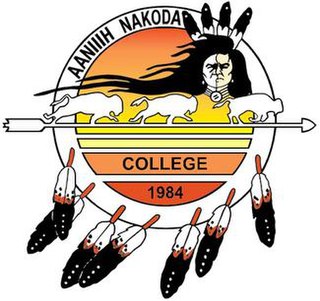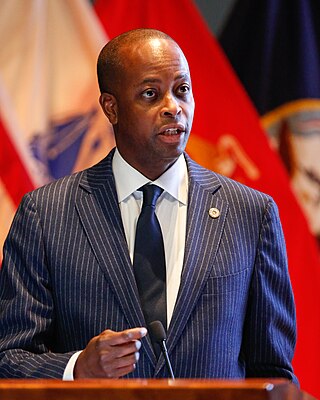Related Research Articles
The American Indian Higher Education Consortium (AIHEC) was established in 1972 to represent the interests of the newly developed tribal colleges, which are controlled and operated by American Indian nations. The four founders were Gerald One Feather of the Oglala Sioux Community College, David Reisling of D-Q University, Pat Locke of the Western Interstate Commission for Higher Education (WICHE), and Helen Schierbeck of the United States Office of Education (USOE). They organized the initial meeting and brought together all who wanted to form such a national organization.. One of the most significant achievements of AIHEC was to work with the United States Congress to authorize in 1994 land-grant status to 29 tribal colleges, achieved in October 1994 under the Elementary and Secondary Education Reauthorization Act.
Historically black colleges and universities (HBCUs) are institutions of higher education in the United States that were established before the Civil Rights Act of 1964 with the intention of primarily serving African Americans. Most of these institutions were founded during the Reconstruction era after the Civil War and are concentrated in the Southern United States. They were primarily founded by Protestant religious groups, until the Second Morill Act of 1890 required educationally segregated states to provide African American, public higher-education schools in order to receive the Act's benefits.

Texas Christian University (TCU) is a private research university in Fort Worth, Texas. It was established in 1873 by brothers Addison and Randolph Clark as the AddRan Male & Female College. It is affiliated with the Christian Church.

Florida Agricultural and Mechanical University (FAMU), commonly known as Florida A&M, is a public historically black land-grant university in Tallahassee, Florida. Founded in 1887, It is the third largest historically black university in the United States by enrollment and the only public historically black university in Florida. It is a member institution of the State University System of Florida, as well as one of the state's land grant universities, and is accredited to award baccalaureate, master's and doctoral degrees by the Commission on Colleges of the Southern Association of Colleges and Schools.
Trinity Washington University is a private Catholic university in Washington, D.C. The university was founded as Trinity College by the Sisters of Notre Dame de Namur in 1897 as the nation's first Catholic liberal arts college for women. Trinity was chartered by an Act of Congress on August 20, 1897. It became Trinity Washington University in 2004.

In the United States, higher education is an optional stage of formal learning following secondary education. It is also referred to as post-secondary education, third-stage, third-level, or tertiary education. It covers stages 5 to 8 on the International ISCED 2011 scale. It is delivered at 3,931 Title IV degree-granting institutions, known as colleges or universities. These may be public or private universities, research universities, liberal arts colleges, community colleges, or for-profit colleges. U.S. higher education is loosely regulated by the government and by several third-party organizations.

The Higher Education Act of 1965 (HEA) was legislation signed into United States law on November 8, 1965, as part of President Lyndon Johnson's Great Society domestic agenda. Johnson chose Texas State University, his alma mater, as the signing site. The law was intended "to strengthen the educational resources of our colleges and universities and to provide financial assistance for students in postsecondary and higher education". It increased federal money given to universities, created scholarships, gave low-interest loans for students, and established a National Teachers Corps. The "financial assistance for students" is covered in Title IV of the HEA.

A Hispanic-serving institution (HSI) is defined in U.S. federal law as an accredited, degree-granting, public or private nonprofit institution of higher education with 25% or higher total undergraduate Hispanic or Latino full-time equivalent (FTE) student enrollment. In the 2021–22 academic year, 572 institutions met the federal criteria, up from 539 institutions in the 2018–19 academic year.
The American Indian College Fund is a nonprofit organization that helps Native American students, providing them with support through scholarships and funding toward higher education. The fund provides an average of 6,000 annual scholarships for American Indian students and also provides support for other needs at the tribal colleges ranging from capital support to cultural preservation activities. Charity Navigator gave the College Fund an overall rating of 88.36 out of 100.
Clifton F. Conrad is Vilas Distinguished Achievement Professor and Professor of Higher Education at the University of Wisconsin–Madison.

In the United States, tribal colleges and universities (TCUs) are a category of higher education, minority-serving institutions defined in the Higher Education Act of 1965. Each qualifies for funding under the Tribally Controlled Colleges and Universities Assistance Act of 1978 or the Navajo Community College Act ; or is cited in section 532 of the Equity in Educational Land-Grant Status Act of 1994.
There are numerous elementary, secondary, and higher institutions of learning in the Commonwealth of Pennsylvania, which is home to 500 public school districts, thousands of private schools, many publicly funded colleges and universities, and over 100 private institutions of higher education.
The Black Ivy League refers to a segment of the historically black colleges (HBCUs) in the United States that attract the majority of high-performing or affluent Black students.

Aaniiih Nakoda College is a public tribal land-grant community college on the Fort Belknap Indian Reservation in Harlem, Montana. The institution incorporates native culture into the curriculum and promotes cultural identity; however, the school is open to both tribal and non-tribal members. Aaniiih Nakoda College is a member of the American Indian Higher Education Consortium (AIHEC), which is a community of tribally and federally chartered institutions working to strengthen tribal nations and make a lasting difference in the lives of American Indians and Alaska Natives. ANC was created in response to the higher education needs of American Indians. ANC generally serves geographically isolated populations that have no other means accessing education beyond the high school level.
Marybeth Gasman is Samuel DeWitt Proctor Endowed Chair in Education and a Distinguished Professor at Rutgers University. She was appointed as Associate Dean for Research in the Rutgers Graduate School of Education in the fall of 2021 and was elected Chair of the Rutgers University-New Brunswick Faculty Council in 2021. In addition to these roles, Gasman is the Executive Director of the Samuel DeWitt Proctor Institute for Leadership, Equity, & Justice as well as the Rutgers Center for Minority Serving Institutions.

Wayne Alix Ian Frederick is a Trinidadian-American scholar, surgeon, and university administrator. He served as president of Howard University in Washington D.C. from July 21, 2014 to August 31, 2023. Frederick also serves as the distinguished Charles R. Drew Professor of Surgery.
The history of higher education in the United States begins in 1636 and continues to the present time. American higher education is known throughout the world for its dramatic expansion. It was also heavily influenced by British models in the colonial era, and German models in the 19th century. The American model includes private schools, mostly founded by religious denominations, as well as universities run by state governments, and a few military academies that are run by the national government.
First-generation college students in the United States are college students whose parents did not complete a baccalaureate degree. Although research has revealed that completion of a baccalaureate degree is significant in terms of upward socioeconomic mobility in the United States, a considerable body of research indicates that these students face significant systemic barriers to postsecondary education access, academic success once enrolled, and degree completion. Many of these obstacles result from systemic racial, cultural, social, and economic inequities.
Saginaw Chippewa Tribal College (SCTC) is a public tribal land-grant community college in Mount Pleasant, Michigan. The college was established in 1998 by the Saginaw Chippewa Tribal Committee.
References
- ↑ Conrad, C. & Gasman, M. (2015). Educating a Diverse Nation: Lessons from Minority Serving Institutions. Harvard University Press
- ↑ "Characteristics of Minority-Serving Institutions and Minority Undergraduates Enrolled in These Institutions" (PDF). U.S. Department of Education, Institute of Education Sciences, National Center for Education Statistics. November 2007. Retrieved 2021-06-24.
- ↑ "The Integrated Postsecondary Education Data System". nces.ed.gov. Retrieved 2021-06-24.
- ↑ Marybeth Gasman & Thai-Huy Nguyen, Making Black Scientists: A Call to Action. (Cambridge, MA: Harvard University Press, 2019).
- ↑ Chen, Edith Wen-Chu (2010). Encyclopedia of Asian American Issues Today. Vol. 1. ABC-CLIO. p. 177. ISBN 978-0-313-34751-1.
- ↑ William Casey Boland, Marybeth Gasman, Andrés Castro Samayoa, and DeShaun Bennett, “The Effect of Enrolling in Minority Serving Institutions on Earnings Compared to Non-Minority Serving Institutions: A College Scorecard Analysis,” Research in Higher Education (2019)
- ↑ "Department of Navy's Historically Black Colleges and Universities/Minority Institutions Program" . Retrieved 2021-06-24.
- ↑ "Minority Serving Institutions (MSI) Partnerships with Community-Based Organizations (CBO)". www.samhsa.gov. 7 February 2014. Retrieved 2021-06-24.
- ↑ "Title III Part B, Strengthening Historically Black Colleges and Universities Program". www2.ed.gov. 2020-07-07. Retrieved 2021-06-24.
- ↑ "Computer and Information Science and Engineering Minority-Serving Institutions Research Expansion Program". www.nsf.gov. Retrieved 2021-06-24.
- ↑ "U.S.C. Title 20 - Education". www.govinfo.gov. Retrieved 2021-06-24.
- ↑ Gasman, Marybeth; Benjamin Baez; Caroline Sotello Viernes Turner (2008). Understanding minority-serving institutions. SUNY Press. ISBN 978-0-7914-7359-7.
- ↑ 20 U.S.C. § 1061
- ↑ 20 U.S.C. § 1059e
- ↑ Jones, Brandy. "Predominantly Black Institutions: Pathways to Black Student Educational Attainment" (PDF). Center for Minority Serving Institutions.
- ↑ 20 U.S.C. § 1101a
- ↑ Garcia, G. A. (2019). Becoming Hispanic-Serving Institutions: Opportunities for Colleges and Universities. Baltimore, MD: Johns Hopkins University Press.
- ↑ 20 U.S.C. § 1059c
- ↑ Warner, L. S. & Gipp, G. (2009). Tradition and culture in the millennium: Tribal colleges and universities. Information Age Publishers.
- ↑ Ginger Stull, Demetrios Spyridakis, Marybeth Gasman, Andrés Castro Samayoa, & Yvette Booker, Redefining Success: How Tribal Colleges and Universities Build Nations, Strengthen Sovereignty, and Persevere through Challenges. Philadelphia, PA: Penn Center for Minority Serving Institutions, 2015.
- ↑ Todd Lundberg, Marybeth Gasman, Clif Conrad, Thai-Huy Nguyen, & Felecia Commodore, “Redefining the Matriculation of Underprepared Students: The Case of Developmental Math Education at Chief Dull Knife College,” Review of Higher Education (2018).
- ↑ 20 U.S.C. § 1067q
- ↑ https://cmsi.gse.rutgers.edu/sites/default/files/MSI_AIANrprt_R3.pdf [ bare URL PDF ]
- ↑ 20 U.S.C. § 1059d
- ↑ 20 U.S.C. § 1059g
- ↑ Rutgers Center for Minority Serving Institutions https://cmsi.gse.rutgers.edu
- ↑ Dolly Nguyen, Mike Nguyen, Thai-Huy Nguyen, Marybeth Gasman, and Clif Conrad, “From Marginalized to Validated: An In-depth Case Study of an Asian American, Native American and Pacific Islander Serving Institution,” Review of Higher Education, 41(3), (2018), 327-363.
- ↑ Maramba, D. & Fong, T. (2020). (Eds.). Transformative practices for minority student success: Accomplishments of Asian American and Native American Pacific Islander-Serving Institutions. Stylus Press.
- ↑ 20 U.S.C. § 1058
- ↑ 82 FR 12499
- ↑ 66 FR 52841
- ↑ 67 FR 45288
- ↑ 69 FR 25293
- ↑ 74 FR 53635